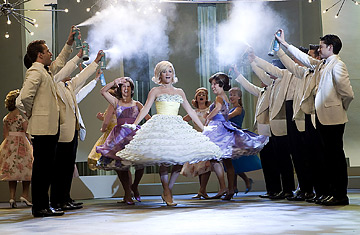
Brittany Snow in Hairspray
If movie musicals haven't caught on with mass audiences since Grease, it's because only a handful of them — Moulin Rouge!, Chicago, Dreamgirls — have been good. Contrast that with the 1960s, when studios churned out memorable musicals — West Side Story, The Sound of Music, Mary Poppins — like they pump out comic book films today. But this year, an eclectic slate of movie musicals is challenging the notion that the genre exists so the mommy quadrant can drag the daddy quadrant out on date night. Opening over the next few weeks is Once, a scrappy, Irish guy-meets-girl yarn made for less than $200,000 and featuring Glen Hansard, the lead singer of the Dublin rock band The Frames as a busker/vacuum repairman trying to launch a recording career singing on street corners. In July comes Hairspray, with newcomer Nikki Blonsky, 18, and old-comers John Travolta and Michelle Pfeiffer (shout-out to Grease 2 fans!) in a cinematic take on the Tony-winning Broadway musical, which was itself a showy take on the 1988 John Waters cult film about teens in a dance contest in Civil Rights-era Baltimore. Fall brings Across the Universe, a 1960s love story set to Beatles songs, directed by The Lion King's Julie Taymor, with a cast including Evan Rachel Wood and Bono. And at year's end, just in time for Oscar season, comes Tim Burton's Sweeney Todd, starring Johnny Depp as the murderous barber in an adaptation of Stephen Sondheim's musical thriller.
So, with much of the movie-going public out of the song and dance habit, how does a modern movie musical hit the right notes? With help from some folks in the trenches, we offer a primer:
1) EXPLAIN WHY EVERYONE'S SINGING
In Once and Dreamgirls, the main characters are musicians, giving them perfectly plausible reasons for walking down the street singing, as opposed to, say, Gene Kelly, who never needed an excuse to curl up to a lamppost and croon. "I wanted to make something naturalistic," says John Carney, who wrote and directed Once after a stint as The Frames' bass player, in part because he thinks his 16-year-old niece's generation has dismissed the movie musical genre as uncool. "It's a shame people are missing out," Carney says. He's onto something — Once won the audience award at the Sundance Film Festival this year, and it has tough-to-charm critics swooning.
2) PRESENT LIFE IN THE KEY OF ME ME ME
In Hairspray, Blonsky and Travolta, who is in drag here as Edna Turnblad in the role Harvey Fierstein played on stage, are sassy mother-daughter spokes-models for plus-size empowerment. "You have to find a theme that contemporary audiences relate to," says Neil Meron, producer of Hairspray and the 2002 film Chicago. "Hairspray is about body image, racial tolerance, what constitutes a family." Think Oprah's Live Your Best Life tour, with a beat and bigger hair.
3) CAMERAS ARE PRETTY FANCY TOOLS. USE 'EM
The 2005 movie version of The Producers looked almost exactly like the hugely successful Broadway show. Which was exactly the problem. Timid Matthew Broderick and loutish Nathan Lane are funny from $100 theater seats, but from $9 movie seats, they're assaultive. Audiences want more subtlety and more cinematic images, like the press conference scene in Chicago, when Renée Zellweger is a marionette on strings pulled by Richard Gere. "We're not interested in recreating a show for film, we're interested in reinventing a show for film," says Meron's producing partner Craig Zadan.
4) PUT A MAD GENIUS IN CHARGE
2001's Moulin Rouge!, a fever dream that weaves together can-can dances, Elton John songs and lots of close-ups of Nicole Kidman's never-ending legs, could only have come from one man's brain. "You could only do that with a Baz," says Meron, meaning Australian director Baz Luhrman. "It's all about his expression as an artist." Burton, an equally idiosyncratic artistic mind, is at work on this year's Sweeney Todd. Some of us are very eager to see what Edward Scissorhands does to meat pies.
5) MAKE SURE YOU'RE GONNA LOVE ME
Even American Idol's Simon Cowell, whose chest cavity apparently developed without a heart inside, rooted for Jennifer Hudson's soulful singer Effie in last year's Dreamgirls. All good movie musicals give us a lovable character to invest in — in Once it's Hansard's tender, awkward busker, in Hairspray Blonsky's cheerful teen reformer and Travolta's well-intentioned big momma. Contrast these huggable characters with, say, 2005's Rent, which celebrates broke, dysfunctional pseudo bohemians who you wish would just shut up and get a job.
6) FEEL FREE TO FOLLOW THE CABARET COROLLARY: YOU DON'T NEED A HAPPY ENDING
"In real life, you don't make that last dash to the airport," says Carney, explaining the edgy ending of Once. His isn't the kind of musical you'll sing in the car on the way home, it's the kind you'll debate... before you pop in the soundtrack.
